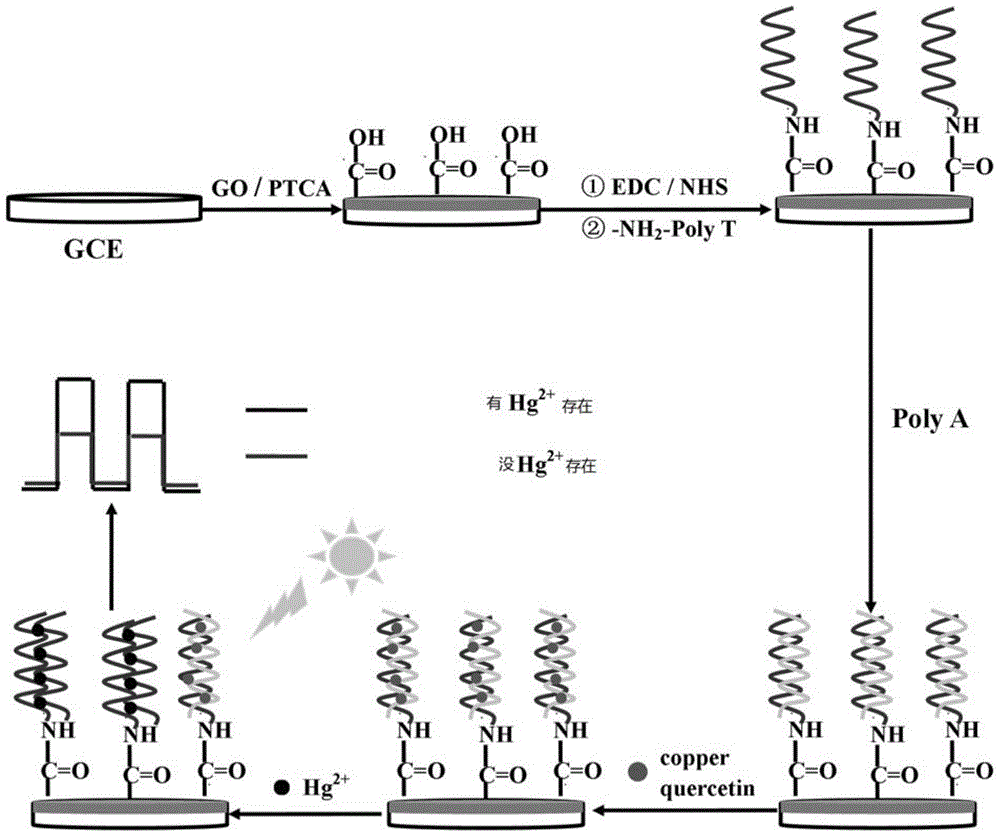Method for detecting mercury ions by nucleic acid aptamer based photoelectrochemistry
A nucleic acid aptamer and photoelectrochemical technology, applied in the field of analysis and testing, can solve the problems of low sensitivity, high toxicity of reagents, expensive equipment, etc., and achieve the effect of increasing the production rate, good specificity, and promoting effective separation
- Summary
- Abstract
- Description
- Claims
- Application Information
AI Technical Summary
Problems solved by technology
Method used
Image
Examples
Embodiment 1
[0022] like figure 1 As shown, the preparation method of perylenetetracarboxylic acid / graphene oxide heterojunction is as follows: First, 2 × 10 -4 mol L -1 of perylenetetracarboxylic acid DMF solution and 2 mg mL -1 Then, the perylene tetracarboxylic acid solution and the graphene oxide solution are fully mixed in a volume ratio of 10:1, and allowed to stand, and a perylene tetracarboxylic acid / graphene oxide heterojunction is formed.
[0023] The glassy carbon electrode was polished with a 0.05 μm particle size aluminum oxide suspension, washed with acetone and pure water in turn, and then left to dry at room temperature. 10 μL of perylene tetracarboxylic acid / graphene oxide heterojunction solution was drop-coated on the surface of glassy carbon electrode and dried at room temperature to prepare perylene tetracarboxylic acid / graphene oxide heterojunction modified electrode. Next, the aminated T bases were immobilized on the surface of the perylenetetracarboxylic acid / grap...
Embodiment 2
[0025] The preparation method of perylenetetracarboxylic acid / graphene oxide heterojunction is as follows: First, prepare 1 × 10 -4 mol L -1 perylenetetracarboxylic acid DMF solution and 1 mg mL -1 Then, the perylene tetracarboxylic acid solution and the graphene oxide solution are fully mixed in a volume ratio of 5:1, and allowed to stand, and a perylene tetracarboxylic acid / graphene oxide heterojunction is formed.
[0026] The glassy carbon electrode was polished with a 0.05 μm particle size aluminum oxide suspension, washed with acetone and pure water in turn, and then left to dry at room temperature. 5 μL of the perylene tetracarboxylic acid / graphene oxide heterojunction solution was drop-coated on the surface of the glassy carbon electrode and dried at room temperature to obtain the perylene tetracarboxylic acid / graphene oxide heterojunction modified electrode. Next, the aminated T bases were immobilized on the surface of the perylenetetracarboxylic acid / graphene oxide ...
Embodiment 3
[0028] The preparation method of perylenetetracarboxylic acid / graphene oxide heterojunction is as follows: First, prepare 0.5×10 -4 mol L -1 perylenetetracarboxylic acid DMF solution and 0.5mg mL -1 Then, the perylene tetracarboxylic acid solution and the graphene oxide solution are fully mixed at a volume ratio of 2.5:1, and allowed to stand, and a perylene tetracarboxylic acid / graphene oxide heterojunction is formed.
[0029] The glassy carbon electrode was polished with a 0.05 μm particle size aluminum oxide suspension, washed with acetone and pure water in turn, and then left to dry at room temperature. 2.5 μL of perylene tetracarboxylic acid / graphene oxide heterojunction solution was drop-coated on the surface of glassy carbon electrode and dried at room temperature to prepare perylene tetracarboxylic acid / graphene oxide heterojunction modified electrode. Next, the aminated T bases were immobilized on the surface of the perylenetetracarboxylic acid / graphene oxide hetero...
PUM
 Login to View More
Login to View More Abstract
Description
Claims
Application Information
 Login to View More
Login to View More - R&D
- Intellectual Property
- Life Sciences
- Materials
- Tech Scout
- Unparalleled Data Quality
- Higher Quality Content
- 60% Fewer Hallucinations
Browse by: Latest US Patents, China's latest patents, Technical Efficacy Thesaurus, Application Domain, Technology Topic, Popular Technical Reports.
© 2025 PatSnap. All rights reserved.Legal|Privacy policy|Modern Slavery Act Transparency Statement|Sitemap|About US| Contact US: help@patsnap.com


